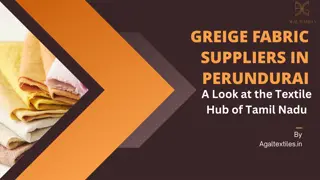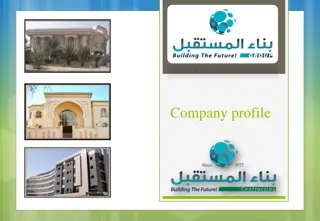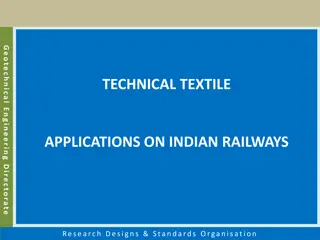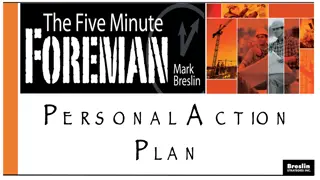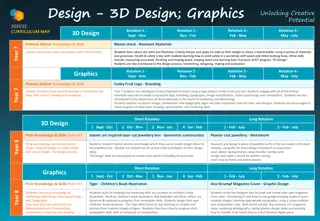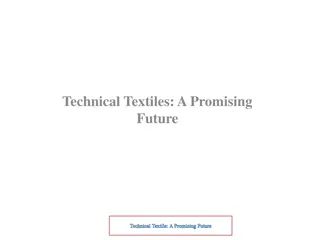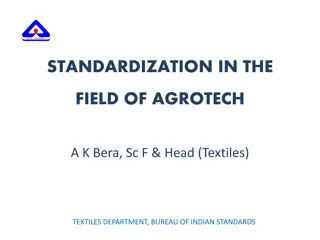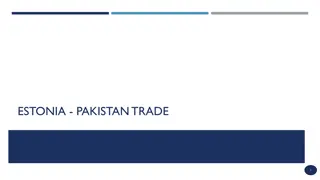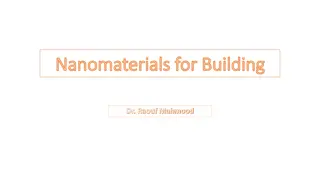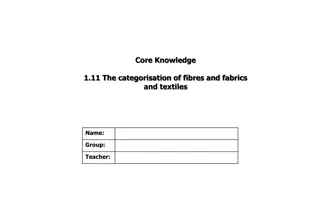Application of Textiles in Building and Construction
Today's era emphasizes building and construction designs with more sunlight, greenery, high performance, cost-saving, and eco-sustainability. Textiles play a crucial role in fulfilling these requirements through applications in Build-tech, Geotextile, Architectural, Construction textiles, Eco-textile, Green roofs, Agro-textile, and new developments like 3D printing for building and construction projects. Textiles are used in various ways such as acoustic and thermal insulation, protection against environmental elements, and enhancing concrete properties through textile fibers. TRC and other textile composite materials are extensively used in the construction of modern infrastructure, providing lightweight, durable, and resilient structures.
Download Presentation

Please find below an Image/Link to download the presentation.
The content on the website is provided AS IS for your information and personal use only. It may not be sold, licensed, or shared on other websites without obtaining consent from the author.If you encounter any issues during the download, it is possible that the publisher has removed the file from their server.
You are allowed to download the files provided on this website for personal or commercial use, subject to the condition that they are used lawfully. All files are the property of their respective owners.
The content on the website is provided AS IS for your information and personal use only. It may not be sold, licensed, or shared on other websites without obtaining consent from the author.
E N D
Presentation Transcript
CLASS: III CLASS: III B.Sc SUBJECT: APPLICATION OF TEXTILES IN INDUSTRY. SUBJECT: APPLICATION OF TEXTILES IN INDUSTRY. B.Sc CDF CDF
Online class(Google meet)prepared by: M.Rishana class: III B.Sc CDF Date:28/10/2021 Application of Textiles in Building and Construction: Today s era, people are more focused in building and construction design have more sunlight, greener, high performance, cost saving and eco sustainable structure. To fulfil these requirements textiles, play a vital role. Textile used in Build-tech, Geotextile, Architectural, Construction textiles, Eco textile, Green roofs, Agro textile, new development of 3D printer and so many applications for building and constructions.
Online class(Google meet)prepared by: M.Rishana class: III B.Sc CDF Date:28/10/2021 Buildtech: Textile used in buildings and Construction are known as Buildtech or Buildtex. Textile material are used in indoor and outdoor for surface as well as hidden applications. Traditionally textiles were used in houses carpets and curtains. But now textiles are used in acoustic & thermal insulation, protection of building against sun, wind, fire, water.
Online class(Google meet)prepared by: M.Rishana class: III B.Sc CDF Date:28/10/2021 Application of buildtech: Textile fibers are used with concrete to enrich its properties, protection against UV and electromagnetic radiations, lowering the cost, eco-friendly and so on. Textile integrated LED and others electroluminescent material applications are increased due to green energy concept. Today, Textile reinforced concrete or, TRC composite material with performances similar to steel reinforced concrete. TRC gives lightweight structures with high durability and quality surfaces in a cost-effective way.
Online class(Google meet)prepared by: M.Rishana class: III B.Sc CDF Date:28/10/2021 TRC and other textile composite materials are used in the construction of buildings, dams, bridges, and roads and collectively comprise the Buildtex sector. They provide mechanical properties such as lightness, strength, and resilience. They are also resistant to many factors such as creep, degradation by chemicals and pollutants as well as the effects of rain, sunlight, acid, and base, etc. In this way, buildtex plays a vital role in the modernization of infrastructure.
Online class(Google meet)prepared by: M.Rishana class: III B.Sc CDF Date:28/10/2021 New Era of Textiles in Building and Construction 1. Green Roofs or Living Roofs: Green Roofs is widely used in buildings and constructions. It is also known as Living roofs due to its attractiveness of better environment. It has excellent features of vegetation, waterproofing membranes, water retention, drainage, and irrigation systems. Living roofs increase the green area ratio in building and construction sites. It allows the green design of commercial sites and recreational roof gardens and terrace areas.
Online class(Google meet)prepared by: M.Rishana class: III B.Sc CDF Date:28/10/2021 Application of green roofs: Application Area Advantages Green roofs and geotextile materials helps to protection against UV radiations, snow and storm situations 1. Reduced Maintenance: Maintained a continuous supply of water to the root zone in the absence of irrigation. Rainwater is retained and supply through geotextile capillary media. 2. Water Retention: With green roofs Planted area increased. These plants absorb pollutants and reduce the greenhouse gas effect. 3. Superior Environment: Green roofs provide insulation properties. It reduces the radiation which maintains the building is cooler in the summer and warmer in winter. 4. Reduced Energy Costs: 5. Better Sound Protection: Green roofs help to reduce noise transfer. 6. Drainage: Drainage properties of a building could be increased via green roofs.
Online class(Google meet)prepared by: M.Rishana class: III B.Sc CDF Date:28/10/2021 Nano-tex: In buildtech and geotextiles, nanotechnology plays an important role in a different way. It improves existing textile properties and offered additional functional performance by increasing chemical, photochemical, biological, and mechanical properties. Nanotechnology make possible to the arrangement of different functions in the same textile properties. Nanofibers and nanotubes are used to made lighter, stronger, acoustic insulation, thermal insulation, controlled light transmission, efficient energy management, cost effective concrete materials in buildtech. That s are more sustainable, run longer and more capable to resist strong shocks generated by earthquakes. Application of nanotextile in building: 1.Self-healing concrete, 2.Reinforcement of critical walls, 3.Localized crack repair, 4.Wrapping of existing columns, 5.Explosive incidents and protection purposes 6.Protection against earthquake or hurricanes, etc.
Online class(Google meet)prepared by: M.Rishana class: III B.Sc CDF Date:28/10/2021 Architectural Textile: Architectural textiles indicate to fabrics or fabric-reinforced membranes used in buildings and constructions of relatively static enclosed environments. It may be used either as load-bearing structural members or as membranes separating the enclosed environment from the outdoors. In the earliest civilization architecture textile used fabrics to make portable, temporary structures were often made by nomads. Textiles were not widely used as engineered architectural applications until the mid 20th century. But today, manufactured fibres and fabric treatments were developed to improve the physical, mechanical, and chemical properties of fabrics.
Online class(Google meet)prepared by: M.Rishana class: III B.Sc CDF Date:28/10/2021 Application of architectural textile: 1.Fabrics are used in building and construction causes it much lighter than conventional building materials. It s allowed to maintain significantly larger span lengths. Fibrous materials can be transported easily. On account of mass packing volume. Architectural textile is ideal for tactical structures. Low mass of fibrous materials poses little risk. That s why it uses in the maximum skyscraper. 2.Architectural material such as fabric could be designed with the desired level of translucency with UV blocking agents specific to a regions climate. In this system allows natural light to enter the structure which reduces the need for artificial lighting, as well as lowering energy costs. Mermet , solar protection fabrics are perfect application to maintain thermal insulation in house. 3.Seismic forces are proportional to a structure s mass. Consequently, heavy steel and concrete structures experience large forces in the earthquake. On the contrary, architectural textile materials have high strength to weight ratios. Therefore, properly designed fabric-based structures perform well during seismic activity. Most of the Japanese house is the perfect example of architectural textile. 4.3D printing technology are providing to made things in a new way. Main advantages of the 3D technology are built houses with cost Saving, environmentally friendly, time saving and very fast way. Different textile material including TRC, used to made durable construction at low cost. 5.Textile is no more used only for interior applications. Today architectural textiles used in civil engineering for temporary and permanent structures. Day by day new textile materials & methods are invented to make most durable textile applications in buildings and contractions.
Online class(Google meet)prepared by: M.Rishana class: III B.Sc CDF Date:28/10/2021 Advantages of Textile in Building and Construction: 1.Viable tools for many civil and environmental engineering applications 2.Increased system performance & life 3.Value engineering 4.Reduce carbon footprint 5.Flexibility in design & selection methodologies 6.Specification based upon functional design intent 7.Make profitable in products for durability, cost, strength to weight ratio and environmental aspect as well.




